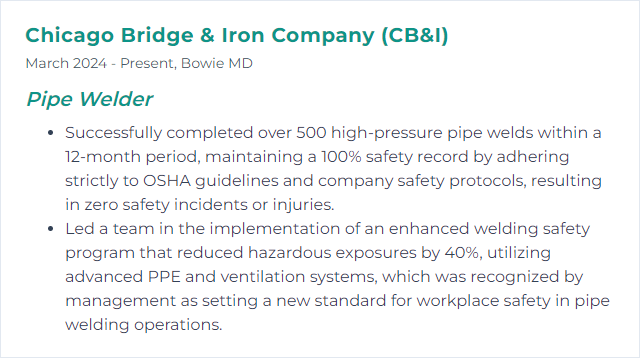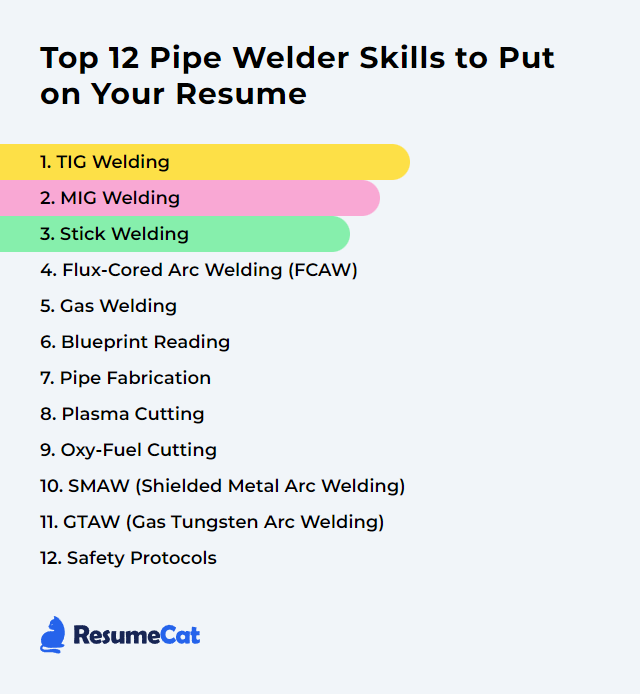Top 12 Pipe Welder Skills to Put on Your Resume
In the highly specialized world of pipe welding, a sharp mix of hands-on technique, code awareness, and steady composure turns jobs into long careers. Hiring managers skim fast; strong skills jump off the page. Make them obvious, make them real, and let the work you’ve done speak in clear, specific terms.
Pipe Welder Skills
- TIG Welding
- MIG Welding
- Stick Welding
- Flux-Cored Arc Welding (FCAW)
- Gas Welding
- Blueprint Reading
- Pipe Fabrication
- Plasma Cutting
- Oxy-Fuel Cutting
- SMAW (Shielded Metal Arc Welding)
- GTAW (Gas Tungsten Arc Welding)
- Safety Protocols
1. TIG Welding
TIG (GTAW) uses a non-consumable tungsten and shielding gas for pinpoint control. For pipe, it’s the go-to for thin-wall, exotic alloys, and root passes where appearance and integrity matter. Clean, calm, precise.
Why It's Important
Leak-tight joints, minimal spatter, low distortion, and beautiful beads. When tolerances shrink and materials get picky, TIG delivers consistent, code-worthy results.
How to Improve TIG Welding Skills
Prep like it matters: Degrease, remove oxides, and use a dedicated stainless brush. Contamination ruins good work.
Choose safer electrodes: Favor 1.5–2% lanthanated or ceriated over thoriated for most steels and stainless. Match diameter to amperage and joint size.
Shielding gas control: Pure argon covers most pipe work; 15–20 cfh is a solid starting range. Extend post-flow for hot tungsten and shiny tie-ins.
Torch discipline: About 15–20 degrees of lead angle, tight arc length (around 1/8 inch or less), and keep that cup steady.
Travel with intent: Consistent speed avoids undercut and overheating. Don’t outrun your shield gas.
Practice positions: 2G through 6G. Walk the cup, freehand when needed, and learn how heat builds around the clock.
Progress shows up in the root. Then the cap. Keep notes. Tweak one variable at a time.
How to Display TIG Welding Skills on Your Resume
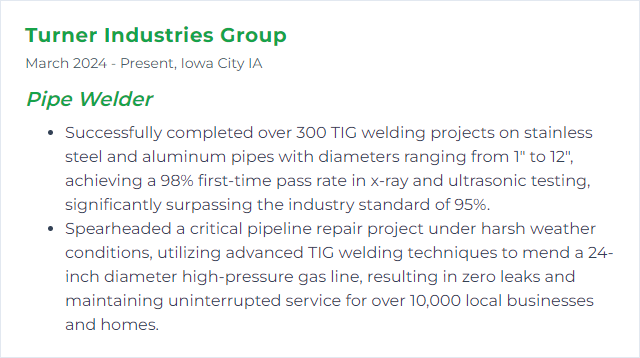
2. MIG Welding
MIG (GMAW) feeds wire and gas through a gun for speed and repeatability. On pipe, it’s common for fills and caps, and with the right process mode—short-circuit, pulse, or spray—can handle roots in qualified procedures.
Why It's Important
Fast deposition, clean workflow, and consistent beads. Great for shop spools, production work, and thicker material when time is tight.
How to Improve MIG Welding Skills
Start clean: Bright metal, tight fit-up, proper bevel and land. Good roots need good prep.
Dial in settings: Match wire type/diameter and mode (short-circuit, pulse, spray) to the joint and position. Fine-tune voltage, WFS, and inductance for wet-in and control.
Gun angle and stickout: Keep stickout short (about 3/8–1/2 inch). Push for better gas coverage in most cases; maintain a steady lead angle.
Manage heat: Avoid burn-through and distortion by balancing travel speed with energy input. Watch the puddle, not the arc.
Position practice: Pipe throws awkward angles. Drill overhead, vertical, and around-the-clock transitions.
Safety first: Ventilation, face/hand protection, and cable management. Keep the workspace tidy.
Record parameters that work. Build a quick-reference chart for different diameters and positions.
How to Display MIG Welding Skills on Your Resume

3. Stick Welding
Stick (SMAW) uses flux-coated electrodes and works almost anywhere—wind, rain, tight corners. Pipefitters lean on it for open-root passes, repairs, and field conditions that punish other processes.
Why It's Important
Portable, forgiving, strong. When you can’t bring the shop to the job, stick brings the job home.
How to Improve Stick Welding Skills
Pick the right rod: E6010/6011 for digging open roots and tight joints; E7018 for low hydrogen strength and clean caps. Store low-hy rods dry and warm.
Set amperage smart: Match to diameter and position. Too hot blows out edges; too cold sticks and lacks fusion.
Work the angle: A small drag angle (about 5–10 degrees) and a tight arc length keep the puddle stable.
Joint prep and cleanliness: Grind, bevel, land, gap. Brush between passes, chip slag thoroughly.
Position reps: 5G and 6G build real control. Practice whip-and-pause for roots, steady weave for fills where allowed.
Mind the slag: Read it. If it’s trapping or tunneling, adjust travel, heat, or rod manipulation.
The bead tells the story—adjust one variable and read the result.
How to Display Stick Welding Skills on Your Resume

4. Flux-Cored Arc Welding (FCAW)
FCAW runs a tubular wire with flux at the core. It lays metal fast, handles wind better than solid wire, and can tackle out-of-position joints with confidence—great for heavy-wall spool work and field installs.
Why It's Important
High deposition, deep penetration, and solid mechanicals. Productivity without throwing quality overboard.
How to Improve Flux-Cored Arc Welding (FCAW) Skills
Parameter control: Voltage, wire feed speed, and stickout (often 3/4 inch or less) must match wire spec and position. Listen to the arc; it should be crisp, not angry.
Match the wire: Choose gas-shielded vs self-shielded based on environment, code, and material. Verify toughness requirements if working cold climates or high-impact service.
Keep it clean: Rust, paint, oil—strip them back. Slag between passes must go.
Technique: Maintain a consistent work and travel angle; use small weaves only where permitted. Avoid trapping slag at sidewalls.
Inspect and correct: Watch for porosity and inclusions. Adjust gas flow, travel, or technique at the first sign.
Safety: Fumes can be heavier—ventilate and wear proper PPE.
Stable, repeatable parameters save time and rework. Build procedures and stick to them.
How to Display Flux-Cored Arc Welding (FCAW) Skills on Your Resume
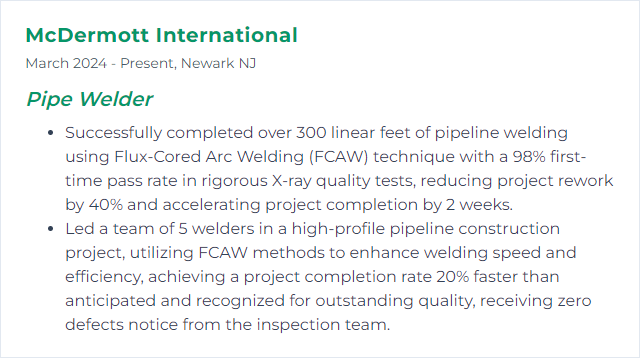
5. Gas Welding
Oxy-fuel fusion welding isn’t the everyday choice for modern pipe fabrication, but it still earns its keep—thin-wall work, repairs, brazing, and field fixes where electric power is limited.
Why It's Important
Control over heat, quiet puddle feedback, and versatile torch work. For some materials and maintenance, it’s exactly the right tool.
How to Improve Gas Welding Skills
Size the tip right: Match torch and tip to wall thickness so the puddle forms quickly but doesn’t run away.
Neutral flame: Balance oxygen and fuel to avoid oxidizing or carburizing the joint.
Clean joints: Bright metal, proper fit-up, and steady hand speed keep the bead smooth and sealed.
Practice torch handling: Control distance, angle, and heat soak. Let the puddle talk.
Safety: Backflow preventers, leak checks, and disciplined cylinder handling—non-negotiable.
Not for every job, but invaluable when it is.
How to Display Gas Welding Skills on Your Resume

6. Blueprint Reading
Pipe welders read more than lines and arrows—they read intent. Symbols, notes, isometrics, callouts, tolerances, and test requirements all shape the joint before a torch ever lights.
Why It's Important
Accurate layout, correct materials, proper weld sizes, and code compliance. Misread drawings cost time and scrap; clear reading prevents both.
How to Improve Blueprint Reading Skills
Master the symbols: Welding symbols, pipe fitting symbols, NDE notes, and finish requirements.
Own the scale: Train your eye on dimensions, offsets, and center-to-center distances. Verify before cutting.
Read isometrics: Practice tracing flow, identifying elevations, and mapping spools and tie-ins.
Study specs: Material grades, PWHT, purge requirements, and procedure limits should be second nature.
Hands-on drills: Build from prints, measure outcomes, and compare to tolerances. Reps beat theory.
Keep learning: Short courses and shop mentoring accelerate understanding.
Clarity on paper means fewer surprises in the fit-up bay.
How to Display Blueprint Reading Skills on Your Resume

7. Pipe Fabrication
Fabrication turns drawings into spools and systems—cutting, beveling, fitting, tacking, welding, and final checks. Tolerances matter. So do sequence, heat control, and cleanliness.
Why It's Important
Good fabrication means faster installs, fewer field reworks, and systems that pass pressure tests the first time.
How to Improve Pipe Fabrication Skills
Fit-up excellence: Consistent gap, land, and high-low control. Use clamps, dogs, and wedges properly.
Measure twice: Verify C-C dimensions, rotations, and offsets. Dry-fit components before committing.
Control distortion: Balanced tacks, skip-weld sequences, interpass temperature control, and proper restraints.
Know your materials: Carbon, stainless, chrome-moly, nickel alloys—each brings prep, purge, and filler nuances.
Quality checks: Visual inspection, root pass verification, purge quality for stainless, and dimensional rechecks.
Document and label: Heat numbers, spool IDs, weld maps, and hold points kept orderly.
Small disciplines add up to spools that fit in the field like they were meant to.
How to Display Pipe Fabrication Skills on Your Resume
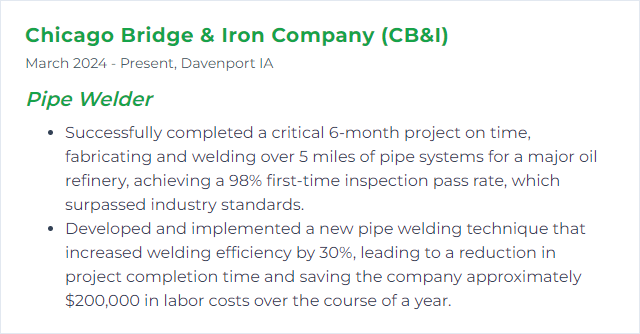
8. Plasma Cutting
Plasma slices conductive metals with a concentrated, high-temperature jet. For pipe, it’s fast and accurate—great for saddles, coupons, and odd fixtures when precision matters.
Why It's Important
Clean edges reduce prep time, improve fit-up, and keep weld quality consistent.
How to Improve Plasma Cutting Skills
Set for the job: Match amperage and travel speed to material thickness. If dross is heavy, you’re off the sweet spot.
Standoff control: Keep a consistent torch-to-work distance. Use guides or templates for repeat cuts.
Maintain consumables: Tips and electrodes wear—replace before they ruin accuracy.
Vent and protect: Sparks, fumes, and noise need respect. PPE and extraction keep you steady and safe.
Good cuts make easier welds. Save time up front; reap it on the back end.
How to Display Plasma Cutting Skills on Your Resume

9. Oxy-Fuel Cutting
Oxy-fuel uses oxygen and fuel gas to preheat steel and then oxidize through it. Simple gear, reliable performance, and smooth bevels when handled with care.
Why It's Important
Field-friendly, cost-effective, and accurate for bevel prep and fit-up on carbon steel pipe.
How to Improve Oxy-Fuel Cutting Skills
Match torch and tip: Size to thickness for clean kerfs and quick starts.
Neutral flame setup: Balance gases to avoid heavy scale or a ragged cut.
Steady motion: Keep a constant speed and distance; watch the preheat and slag flow to gauge progress.
Bevel consistently: Maintain angle through the cut; use guides for repeatability.
Keep equipment healthy: Clean tips, check hoses, confirm flashback arrestors—a routine that prevents headaches.
Once tuned, it’s a workhorse. Let the flame do the work.
How to Display Oxy-Fuel Cutting Skills on Your Resume
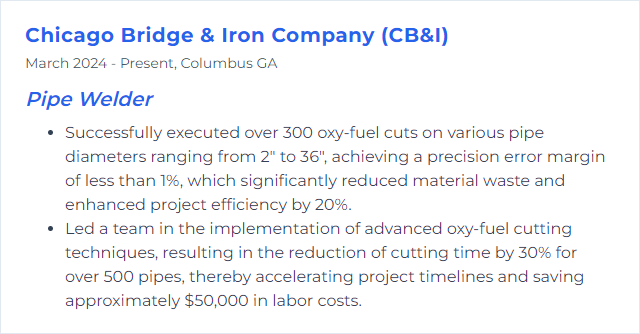
10. SMAW (Shielded Metal Arc Welding)
SMAW is stick welding by its formal name. Flux-coated electrodes, strong joints, fewer accessories. It thrives in field conditions and tough positions.
Why It's Important
Versatile, proven, code-friendly. Pipe welders count on it for open roots, structural tie-ins, and repair work.
How to Improve SMAW (Shielded Metal Arc Welding) Skills
Repetition across positions: Work from 1G to 6G. Build muscle memory for rod angle and arc length.
Electrode knowledge: Understand classifications, storage, and reconditioning for low-hydrogen rods.
Heat and arc control: Short arc, steady travel, and amperage matched to diameter and position.
Surface prep: Grind to clean metal and remove slag fully between passes.
Technique variety: Whip for penetration where allowed; controlled weaves for fills and caps under the procedure.
PPE and ventilation: Keep eyes, lungs, and skin protected, always.
Keep learning: Mentorship, test practice, and honest feedback sharpen results.
Stay fit: Flexibility and endurance make long weld-outs safer and steadier.
The simplest process can be the toughest to master. Consistency wins.
How to Display SMAW (Shielded Metal Arc Welding) Skills on Your Resume
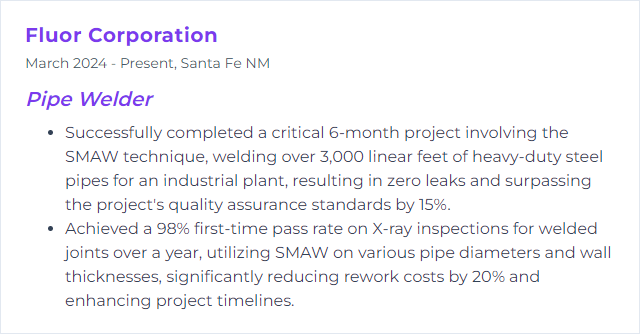
11. GTAW (Gas Tungsten Arc Welding)
GTAW is TIG by its code name. Non-consumable tungsten, inert gas shield, and surgical control over the puddle—ideal for critical pipe welds and thin sections.
Why It's Important
When the spec demands clean, tight, and true, GTAW delivers. It minimizes distortion and nails root quality with the right prep and purge.
How to Improve GTAW (Gas Tungsten Arc Welding) Skills
Immaculate prep: Degrease, abrade lightly, and keep tools material-specific to avoid cross-contamination.
Electrode choices: 1.5–2% lanthanated works across steels and stainless; sharpen for DC steels, ball slightly for AC aluminum.
Machine setup: Match amperage and AC/DC mode to alloy and thickness. Use high-frequency start and adequate post-flow.
Puddle control: Tight arc, proper torch angle, and calm filler additions. Walk the cup for stability on pipe where it fits.
Shielding strategy: Pure argon suits most work; specialized mixes may be used for certain austenitic or nickel alloys under qualified procedures. Maintain 15–20 cfh and avoid turbulent flow.
Position practice: Root, hot, fill, cap—clock it from 4 to 10 and back again. Practice tie-ins.
Health and safety: Eye protection, gloves, sleeves, and ventilation—especially on stainless and coated materials.
Small adjustments change everything. Track what works and repeat it.
How to Display GTAW (Gas Tungsten Arc Welding) Skills on Your Resume

12. Safety Protocols
Safety for pipe welders isn’t abstract—it’s daily habit. Hot metal, live arcs, confined spaces, fumes, and pressure tests demand respect and planning.
Why It's Important
Protects people, preserves equipment, and prevents downtime. Safe shops and sites produce better work, period.
How to Improve Safety Protocols Skills
Focused training: Task-specific instruction, refreshers, and verified competency for each process and hazard.
PPE that fits the job: Auto-darkening helmets, FR clothing, gloves, boots, hearing protection, and respiratory protection where needed.
Equipment upkeep: Inspect leads, torches, regulators, and machines. Fix or tag out—don’t nurse failing gear.
Ventilation and extraction: Use local fume capture, especially on stainless, galvanized, or tight spaces. Test air when required.
Work area control: Clear signage, barriers, tidy cable runs, and housekeeping that prevents trips and fires.
Emergency readiness: Drills, first-aid kits, extinguishers, eyewash, and clear communication plans.
Routine audits: Walk the floor, note hazards, correct quickly, and document changes.
Safety is a habit loop. Build it, keep it, and the whole crew benefits.
How to Display Safety Protocols Skills on Your Resume
